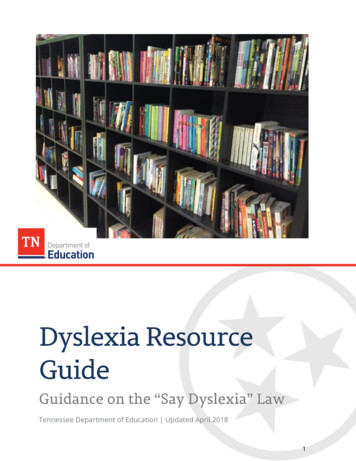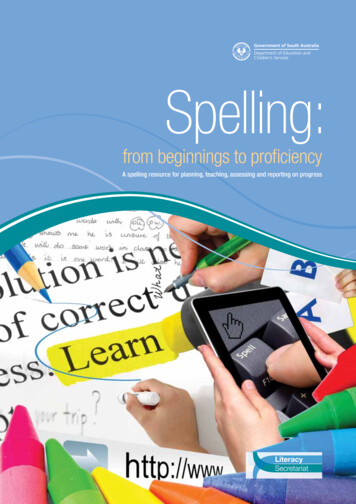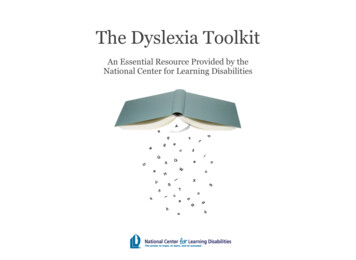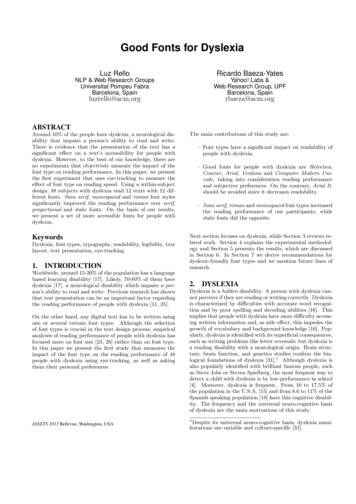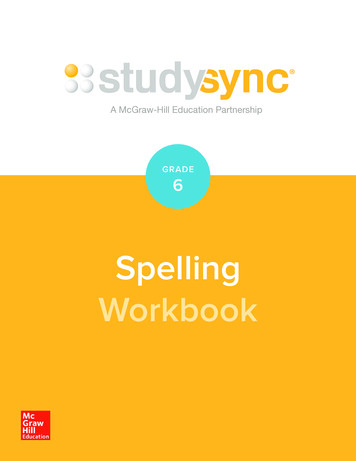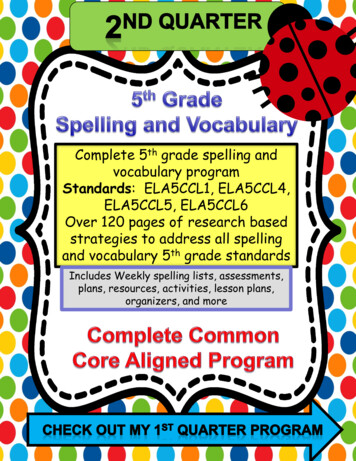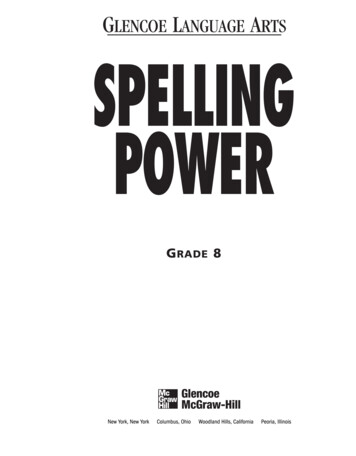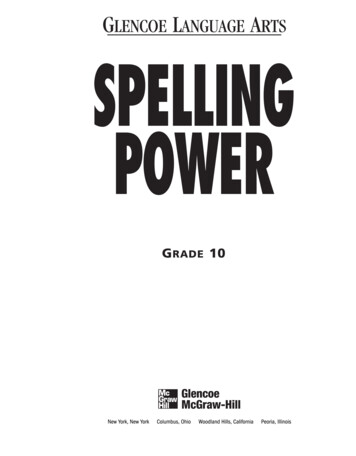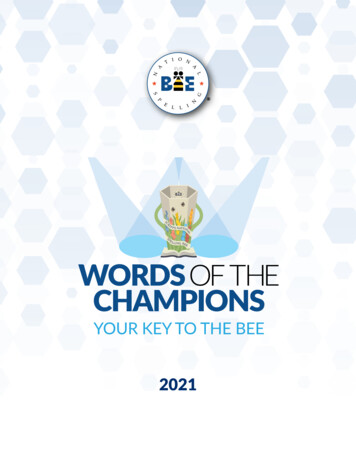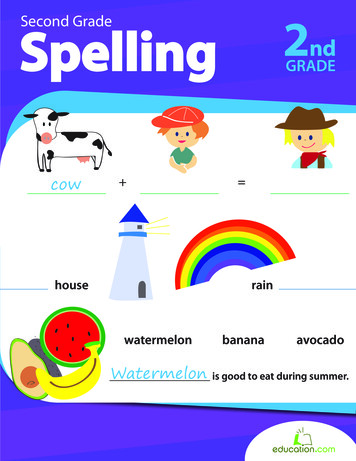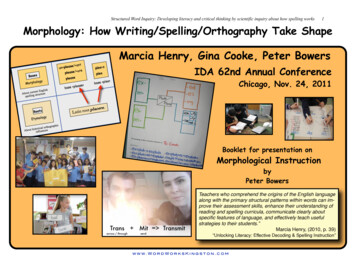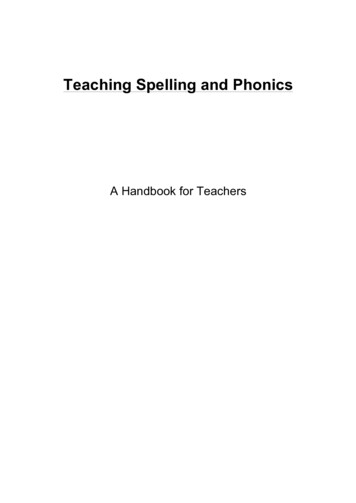
Transcription
Teaching Spelling and PhonicsA Handbook for Teachers
ContentsWhy do children need to spell correctly?What do children need to learn to spell correctly?What are the expectations of how spelling and phonics should betaught at XXX school?How should phonics and spelling should be taught?Useful memorising strategiesKey spelling patterns The Importance of Syllables in SpellingPrefixes as an aid to spellingSuffixes - their importance in spellingSpelling words ending ic and ickWords ending -er, -or, and –arWords ending ical, icle and aclePractising Spellings At HomeSpelling PostersPhonic and spelling games
Why children need to learn to spell correctly?This section is based on material from Spelling it Right at http: //www.spelling.hemscott.net.Poor spelling creates a bad impression - it’s one of the first things a reader noticesExaminers, teachers, prospective employers, often place a lot of weight on spellingAnxiety about spelling inhibits a child's writing, especially their choice of words Even in these days of word processors there are still times when we need to write To improve and develop their spelling children needto:Develop an interest in wordsFeel safe about trying new words, not just words they're sure aboutLearn about, the way words are built up using syllablesKnow about the basic spelling patterns of EnglishHave a range of memorizing strategiesExplore the meanings of wordsUnderstand prefixes and suffixesWrite for their own enjoyment, without the fear that they will be criticized Read for pleasure What are the expectations of how spelling andphonics should be taught at XXX school? In Foundation and Year 1, there should be a daily phonics lessonIn Year 2,there should be a discrete phonics and/or spelling lesson at least 3 timesa week.In Key Stage 2, there should be a discrete spelling lesson one a week, with plannedopportunities at least 3 times a week for consolidation and re-enforcementHow should phonics and spelling should be taught? Teaching should be focussed and pacyThere needs to be clear continuity and progression – teaching should be based onchildren’s strengths and weaknesses rather than their age or year group, andobjectives should be drawn from the school schemes of work.A variety of groupings should be used including whole class teaching, group workand paired work.Children could work in ability groups, being set across a year group, if this wouldcontribute to effective teaching and learningA variety of teaching methods should be used including direct exposition, gamesand investigation of spelling rules and patterns.Children should be taught methods to enable them to learn new spellings
Useful memorising strategiesWhen you come across a new word ALWAYS use theLOOK - THINK - COVER - WRITE - CHECK method to memorize it.LOOK carefully at the new word. How can you break it into smaller bits? Do any of thesmaller bits remind you of the patterns of letters from other words?THINK about the parts of the words, which might cause problems - double letters forinstance, or a vowel that isn't pronounced as you would expect.COVER the word and close your eyes. Try to see it in your mind's eye.WRITE the word down without looking back.CHECK to see if you're right. If not, look carefully at where you went wrong and try again.More Hot Tips* Whenever you have to copy a new word from the whiteboard, from a book, or from thedictionary, always try to write the whole word in one go.Don't keep looking back after every few letters.* Try finger-writing: while you're THINKing about the word, pretend to write it with yourfinger, on your desk or on your hand.Mnemonics are useful for particularly tricky words, or for key spelling patterns: Ould – Oh, you, lucky duck (should, could, would) Ound – Oh you naughty duck (ground, found) Laugh – Laugh At Ugly Goat Hair Because – Big Elephants Can Always Understand Small Elephants Island – an island is land surrounded by water Necessary – 1 collar and 2 sleeves are necessary Piece – a piece of pie Parliament – Liam went to the Houses of parliament Separate – there is a rat in separate Secretary – a good secretary can keep a secret Terrible – Ribs feel terrible Business – going by bus is good business Rhythm – rhythm gets your 2 hips moving Accommodation – 2 cats, 2 mice, 1 dog - accommodation Soldier – soldiers sometimes die in battle Quiet – keep quiet about my diet Guitar – I only play guitar when I’m drinking fruit juice
Key spelling patternsThis section is based on material from Spelling it Right at http://www.spelling.hemscott.net .Children need to be taught useful spelling patterns and rules. One good technique is tobegin by giving children a list of words to sort. Then ask them to look carefully at how theysorted the words, and see if they can spot the spelling rule. Finish by explaining the rule,giving further words, and see if the children can use the rule to sort the words morequickly.If you are sending home spellings that follow a pattern, it’s a good idea to make thatpattern explicit, so that parents can help their children to learn their spellings.The Importance of Syllables in SpellingAll good spellers are skilful at breaking words up into syllables.care-fulhos-pit-alu-ni-ver-si-tyBreaking a word into syllables makes it easier to deal with one small bit at a time.Prefixes as an aid to spellingA prefix is a group of letters placed at the start of a root word to change its meaning. Somecomplicated words are less difficult to spell if you are familiar with prefixes.Here are some common examples in the following subsupertransun-MEANINGagainst or opposite toselfnot, or awaynotnotnotnotbetweenwrongafterbeforefor, or forwardagain, or backunderaboveacrossnot, or in reverseEXAMPLESanticlockwise, antibioticautobiography, automatdissimilar, disconnectinsane, inhumanillogical, illegalimmature, improbableirrelevant, irregularinternational, intermarrymisunderstand, misspellpostnatal, postscriptprenatal, prehistoricpropose, pro-Britishrewrite, reconsidersubmarine, substandardsupervisor, superhumantransport, transplantunfinished, unarmed
Suffixes - their importance in spellingA suffix is simply an ending that's added to a base word to form a new word.A key thing to know about a suffix is whether it starts with a consonant or a vowel.Adding a suffix to “magic e” wordsWhen you add a consonant suffix the base word doesn't change.When you add a vowel suffix, drop the silent e. Remember to drop the e when adding avowel suffix. (Note that y is regarded as a vowel suffix, so laze y lazy)Baseword consonantsuffixBaseword lculate lylatelatestextremeextremelyexpenseexpensiveAdding suffixes to words ending -ce and -geThere are exceptions to the above “magic e” rule – which is why it’s probably better to callit a pattern rather than a rule.Here's the main one:Where the base word ends in -ce or -ge, then you keep the silent e before -able and -ous.So:enforce ablenotice ableservice ablecourage ousoutrage ous usWhen should you doubling consonants when adding a suffix?
Luckily there's a very useful pattern to help us.If the base word has:one syllableone short vowelone consonant at the endyou double the final consonant when you add a vowel suffixbed ingfun y bedding, funnyflat esthot er flattest hotterIf the base word has:one syllableone short vowelone consonant at the endyou keep the base word the same when you add a consonant suffixbag ful bagful,wet ness wetnessSuffixes and Stressed SyllablesIf the stress is on the first syllable the base word doesn't change:Profit - profitable Enter - enteredOrder - orderingIf the stress is on the last syllable, double the final consonant before adding a vowel suffix.No change if a consonant suffix is added.Begin beginningEquip equippedRegret regretfulCommit commitmentAdding a suffix to words ending yThere are two important patterns to learn:* If the word ends in a vowel y, the base word doesn't change:delay ed delayedemploy ment employment* If the word ends in a consonant y, when you add any suffix except -ing, then change they to i:reply ed repliedbusy ness businesspity ful pitifulbut reply ing replying
Spelling words ending ic and ickSame sound but two spellings. However there is a simple way to spot the difference.The words with only one syllable end in -ick.The words having more than one syllable end in -ic.There are only a few exceptions to this pattern and these usually happen where two wordsare joined together as in homesick and candlestick.Words ending -er, -or, and -arThere are lots of words in English which end with the -er sound. But when you listen tothese words you can't be sure whether the sound is made by -er, -or or -ar.There's no easy rule but there are a few helpful word patterns: There are more than ten times as many words ending with -er than -or and -artogether.So, if you guess -er then there's a good chance that you'll be right! Verbs ending in a silent e usually change to nouns by ending -er:dive/diver wade/wader write/writer avenge/avenger -er is also the most common way of ending a word for someone carrying out anaction:Actionreportingplayingfighting -or is used when the base word ends in -ate, -ct, -it :calculatecontractvisit Person carrying out the here is no especially useful pattern to recognise words that end in -ar except tosay that many of them finish with -lar:regular popular similar pillarBut other than that it's just a matter of memorizing the -ar words as you comeacross them. Mispronouncing the ending so that it rhymes with the -ar- in market isa handy memory trick.Words ending ical, icle and acleAdjectives all end with -ical, and the nouns end with -acle or -icle.Handy Tip: Nearly all the words that end with this sound will be adjectives and willtherefore end with -ical.Any more spelling patterns? Check with KS2 book.
Practising Spellings At HomeIf you are sending spellings home, you may want to suggest ways in which parents couldhelp their children. You could send home a sheet with a bank of ideas, or send a differentone home each week with the new spelling list.A variety of games should help to keep both children and parents interested andmotivated. The games below have been designed for home learning, but you could alsouse them in the classroom.1) Word SearchCreate your own word searches using your spelling words. Or use this link to get yourcomputer to do it for SearchSetupForm.asp2) Draw your words on .html#%7CHERE3) Air spelling:Choose a spelling word. With your index finger write the word in the air slowly, say eachletter. Your parent needs to remind you that you need to be able to 'see' the letters youhave written in the air. When you have finished writing the word underline it and say theword again. Now get you parents to ask you questions the about the word. For examplethey could ask 'What is the first letter?' 'What is the last letter?' 'How many letters arethere?' ect.4) Media Search:Using a newspaper or magazine you have 15 minutes to look for your spelling words.Circle them in different coloured crayon. Which of your spellings words was used the mosttimes?5) Shaving Cream Practice:An easy way to clean those dirty tables is to finger paint on them with shaving cream.Squirt some on the table (with your parents permission and supervision!) and then practicespelling your words by writing them with your finger in the shaving cream.6) Salt Box Spelling:Ask your parents pour salt into a shallow box or tray (about 3cm deep) and then practicewriting you spellings in it with your finger.7) Scrabble Spelling:Find the letters you need to spell you words and then mix them up in the bag. Get yourparents to time you unscrambling your letters. For extra maths practice you could find outthe value of each of you words.8) Pyramid Power:Sort your words into a list from easiest to hardest. Write the easiest word at the top of thepage near the middle. Write the next easiest word twice underneath. Write the third wordthree times underneath again until you have built your pyramid
9) Ransom Note:Cut the letters needed to for your words from a newspaper or magazine and glue themdown to spell the words.10) Spell It With Beans:Use Lima beans (or any dried beans or lentils) to spell out your words. If you glue themonto separate pieces of card then you made a great set of flash cards to practice with forthe rest of the week.11) Pipe Cleaners Or Tooth Picks:These are just a couple of suggestions of things you could use to for your spelling words.12) Tasty Words:Just like above but this time try and find tasty things to spell your words with, like raisins.Then when you spell them right you get to eat them!13) Design A Word:Pick one word and write it in bubble letters. Colour in each letter in a different pattern.14) Sign Your Word:Practice spelling your words by signing each letter. To see the New Zealand SignLanguage Alphabet df15) Water wash:Use a paintbrush and water to write your words outside on concrete or pavements.16) ABC Order:Write your words out in alphabetical order. Then write them in reverse alphabetical order.17) Story Time:Write a short story using all your words. Don't forget to check your punctuation!18) Simple Sentence:Write a sentence for each of your words. Remember each sentence must start with acapital letter and end with a full stop.19) Colourful Words:Use two different coloured pens to write your words. One to write the consonants and oneto write the vowels. Do this a couple of times then write the whole word in one colour.20) Memory Game:Make pairs of word cards. Turn them all over and mix them up. flip over two cards, if theymatch you get to keep them, if not you have to turn them over again. Try and match all thepairs.21) Finger Tracing:Use your finger to spell out each of your words on your mum or dad's back. Then it's theirturn to write the words on your back for your to feel and spell.
22) Spelling Steps:Write your words as if they were steps, adding one letter each time. (It's much easier doingthis on squared paper)23) Scrambled Words:Write your words then write them again with all the letters mixed up.24) X-Words:Find two of your spelling words with the same letter in and write them so they criss cross.25) Ambidextrous:Swap your pen into the hand that you don't normally write with. Now try writing out yourspellings with that hand.26) Telephone Words:Translate your words into numbers from the telephone keypad.27) Secret Agent:Write out the alphabet, then give each letter a different number from 1 to 26. (a 1, b 2,c 3 ect.) Now you can spell out your words in secret code.28) Missing Letters:Ask your mum or dad to write out one of your words loads of times on piece of paper, buteach time they have to miss out a letter or two. Then you have to fill in the missing letters.After you have checked them all try it again with another word.29) Listen Carefully:Ask your parents to spell out one of your words then you have to say what the word isthey've spelt out.30) Acrostic:Use words that start with each letter in you spelling word. Your more likely to remember itif it makes sense!31) spell – a – doodleCreate a picture and use yor spelling words to fill in the detail. Each word must be writtenthree times. e.g. a picture of clouds would have the lines formed with spelling words. Youcan add to the challenge by giving specific picture topics.
Learning how to spellSUSStudy the wordUnderline thedifficult part(s)Say the wordcarefully
Learning how to spell“Writing theword” On someone’s back On your desk (large) With your eyes
Learning how to spellSpeed WritingHow often can youwritethewordcorrectlyinoneminute?Page 14 of 47
Learning how to spellMnemonicsMaking up a “story” to help spell a wordwas – was auntie sad?Page 15 of 47
Learning how to spellSyllables/ChunksBreaking the wordsinto parts / clappingthe soundsgoingrunningreturnedPage 16 of 47go/ingrun/ningre turn ed
Learning how to spellLook forsmall wordsinside the wordabout - a, out, boutteacher – tea, each,her, achePage 17 of 47
Learning how to spellBe positiveWe shalltry ourbestPage 18 of 47
Learning how to spellWords thatlook the sameback is like Think pack and sackPage 19 of 47
Learning how to spellUse ofcoloursUse a differentcolour for eachLetterPage 20 of 47
Learning how to spellOdd one out Work with others From a list of threewords, think ofreasons why eachword is differentgoingPage 21 of 47greenbig
Learning how to spellDifferentsizes ofletterswoman – WoMaNreturning - ReTuRnInGPage 22 of 47
Learning how to spellShapes ofwordsDraw the shape ofthe wordtablePage 23 of 47
Learning how to spellMaking wordswith letters Put all the letters inan arc Listen to word Place letters inboxesPage 24 of 47
Learning how to spellIn sand or using differentmaterials (paint) different textures(sandpaper)Page 25 of 47
Learning how to spellVisualising Look at your word “Throw” it at thewall Can you still “see”it? Spell it aloudPage 26 of 47
Learning how to spellWriting theword in fancyletters Bubble writing Cursive ItalicsPage 27 of 47
Learning how to spellUse a spellingrule “i” before “e”except after “c” change the “y” to “i”and add “es”Page 28 of 47
Learning how to spellLookSayCoverWriteCheckPage 29 of 47
Learning how to spellUsingpost-its place post-its insuitable places ateye levelPage 30 of 47
Learning how to spellRecordingyour ownvoice say the word spell the word listen echoLearning how to spellPage 31 of 47
Three TimesWrite the word 3times in differentcoloursthree threethreeLearning how to spellPage 32 of 47
PyramidWritingWrite your word inthe shape of apyramidwwawasLearning how to spellPage 33 of 47
Consonant CirclesaeiWrite the word thencircle all theconsonantsLearning how to spellPage 34 of 47
Blue vowelsaeiouWrite the word thengo over each vowel inbluebecauseLearning how to spellPage 35 of 47
Wordswithoutvowelsb c sWrite each word with a lineinstead of each vowel.Go back later and fill in themissing vowelsPage 36 of 47
Phonic and Spelling GamesA bank of ideas to aid the teaching of phonics and spelling.Sound JumpAim: grapheme identificationEquipment: grapheme cards, - one for each childGame§ Children sit in circle, give every child a card which is placed on the floor in front ofthem.§ Each child identifies their phoneme (sound), with help from others if necessary.§ Teacher calls out a phoneme and the child with corresponding grapheme (letter)jumps up quickly§ Meanwhile the rest of the class has to try to point to that grapheme before itsowner has jumped up!Box of soundsAim: grapheme & initial sound identificationEquipment: grapheme cards, - one for each child, objects with initial sounds to match cardsGame§ Children sit in circle.§ Look at the objects and identify initial sounds. Place objects in centre of circle.§ Pass a box grapheme cards around the circle singing “Box of sounds, pass itround, pass it round, pass it round. Box of sounds pass it round, what sound is it?”(“London bridge is falling down” tune)§ Child holding box at the end of the song takes out the top card, identifies soundand places it next to corresponding object.Bag of objectsAim: grapheme & initial sound identificationEquipment: grapheme cards, objects with initial sounds to match cards, bag for objectsGame§ Children sit in circle.§ Look at grapheme cards, identify sounds and arrange in centre of circle§ Pass a bag of objects around the circle singing “Bag of objects, pass it round, passit round, pass it round. Bag of objects pass it round, what’s in the bag?” (Londonbridge is falling down” tune)§ Child holding bag at the end of the song takes out an object, identifies it and it’sinitial sound, then places it next to the corresponding card.Alliteration (initial sound) matchAim: grapheme & initial sound identificationEquipment: grapheme cards, - one for each child, alliteration cardsGame§ Children sit in circle, give every child a card which is placed on the floor in front ofthem.§ Each child identifies their phoneme (sound), with help from others if necessary.§ Teacher looks at an alliteration card and calls out the subjects (e.g. whales in thewater)Page 37 of 47
§ Child with corresponding grapheme card calls out the sound and holds up theircard.Noughts and crossesAim: grapheme identificationEquipment: whiteboard, 3 coloured markersGame§ Divide class into 2 groups (e.g. name them 2 different colours), and sit them apart.§ In black, draw a noughts & crosses grid and write in 9 graphemes/digraphs.§ A member from first team calls out a phoneme from the square he wants to go first.§ Someone else from his team has to call out a word with a corresponding initialsound.§ Teacher then rubs out the grapheme and replaces it with a smiley face in thatteam’s colour.§ Continue with other team until either team win by winning 3 smiley faces in a row.Stepping StonesAim: grapheme identificationEquipment: grapheme cardsGame§ Place cards in a large circle§ Children step from card to card while singing “walk around and find a sound, What will I stop on?”§ Going round the circle, each child jumps back off their card and immediately callsout the sound.S.M.Say a sound Aim: grapheme & initial sound identificationEquipment: alliteration cardsGame§ Hold up alliteration card while children sing the rhyme§ Starting with the adult, everyone has to think of something beginning with thesound on the cardS.M.Find a soundAim: grapheme & initial sound identificationEquipment: grapheme cards in a boxGame§ Children sit in a circle§ The box of cards are passed around the circle while singing: “pass the sound boxround and round etc what can you find?”§ Child identifies the phoneme and then finds something in the room beginning withthat sound and places the card next to the object/ brings it back to the circleS.M.Who can cross the river?Aim: grapheme identification & cvc blendingEquipment: white board, marker pensGame§ Draw a river across the board. Write 3 letters at the top (ones which make up acvc word)§ Draw a crocodile in the river and a child’s name next to the cvc word§ Sing “who can cross the river, who can cross the river, who can cross the river andreach the other side?”§ Child has to identify sounds and blend to make the cvc wordPage 38 of 47
§ § § When child is successful, then sing “ has crossed the river and reached the other side”. Write child’s name on other side of river.ALTERNATIVE VERSION: lay out 2 ropes to represent river. Place 3 carpetsquares as stepping stones across the river, place 3 grapheme cards - one oneach carpet square.Child sounds out the phonemes as s/he steps across the river, then blends thesounds together to hear the word.S.M.PairsAim: grapheme identificationEquipment: grapheme cards - 2 sets (select no more than 5- 8 different letters)Game§ Sit children in horse shoe in front of you§ Identify phonemes with group as you hold up the cards, then place them upsidedown in a grid pattern in centre of horse shoe facing the children.§ Facing into the horse shoe so the group can all see, let each child turn over 3cards, identifying phonemes as each card is turned over. Ensure cards arereplaced in same position if not “won”.§ Wining cards are placed in front of successful children.“Sound jump” game could be played at end of game.Pick a letter Aim: grapheme & initial sound identificationEquipment: grapheme cards, - one for each child, in a boxGame§ Sit children in a circle and give first child the box.§ Child picks a card from the box, identifies phoneme (sound) and thinks ofsomething beginning with that phoneme.§ Pass box to next child and repeat.Try to keep the pace fast.I spy with my little eyeAim: grapheme & initial sound identificationEquipment: grapheme cards in a box, and objects/pictures with initial sounds to matchgraphemes.Game§ Sit children in a circle and place objects in centre.§ Give first child the box.§ Child picks a card from the box, and says, “I spy with my little eye somethingbeginning with (says sound on card) and looks for a corresponding object.Collects object and places it with card in front of him.§ Continue game round circle.Medial VowelsAim: grapheme & medial sound identificationEquipment: objects -with cvc construction ( in basket), the 5 vowel grapheme cardsGame§ Sit children in horse shoe in front of you§ Identify vowel graphemes and place in horse shoe, facing children§ Pass basket of objects while singing abcdefg etc. Child holding basket on “z”,chooses an object, says its name then segments its sounds to identify its middlesound. The child then places the object underneath the correct vowel. Repeat untilall objects have been placed.§ This game could be ended by writing the spelling of an object on board and askinga child to read the word by blending the sounds then collecting the object andplacing it back in the basket.Page 39 of 47
This game could also be adapted to focus on initial or final sounds.Initial Sound BingoAim: grapheme & initial sound identificationEquipment : selection of objects with different initial sounds, A4 boards divided into 3columns, basket, grapheme cards to match object’s initial soundsGame§ Each child has a board on which they place any 3 grapheme cards in the 3columns. Each child identifies their graphemes§ Teacher holds up an object for the children to name it and identify its initial sound.Child with corresponding card claims object and places it next to its letter.§ First child with 3 objects is the winner but who will be second, third etc?Initial Sound Jump Up Aim: grapheme & initial sound identificationEquipment: grapheme cardsGive each child a grapheme card. You say a word and the child with the graphemerepresenting the initial sound must jump up before the other children point to it. If the childrenseem receptive to continuing, repeat with different selection of graphemes.Alliteration GenerationAim: generation of alliteration wordsEquipment: selection of objects to pass around circle and grapheme cards to match initialsounds, basket Lay objects in centre of circle and explain that the first child will pick a card from a pilehanded to him (in a basket) identify the sound, then find the object which begins with thesame sound. Encourage the group to call out other words, which begin with same sound.The object will then be passed around the circle with each child saying” .(cat) beginswith cer and .(child thinks of another word which begins with the same sound) collarbegins with cer. “The next child begins by repeating “cat begins with cer and (adds his own word)”. Wordscan be repeated.Repeat game with another object.Initial letters/sounds Basketball(A fun way to revise letters and sounds!)Need – a soft ball, a bin or hoop to throw the ball throughDivide the class into 2 teams. Each team sends a player to the front and theteacher says a letter or a sound. The first of the 2 players to say a word thatstarts with the letter or sound gets to have a throw. If they get the ball in the goal(the bin or hoop) the team scores a point.VARIATIONSBasketball Final letters/soundsPlayed as above but students must give a word that ends with the letter orsound.Basketball AntonymsPlayed as above but students must give an antonym for the word given by theteacher.Basketball SynonymsPlayed as above but students must give a synonym for the word given by theteacher.Page 40 of 47
Beat the Buzzer Aim: spelling gameEquipment – a soft ballPlayers sit in a circle. One player starts by throwing the ball to another playerand calling out a 3 letter word, e.g. HAT.The player with the ball has to say 3 words beginning with the 3 letters of theword, e.g. horse, apple, tower.This has to be done before the player who threw the ball counts to 12 and thensays buzz, i.e. 1, 2, 11, 12, BUZZ.A player is out if he doesn’t Beat the Buzzer.As the game progresses the counting can be shortened to 10 or even 8.Older players can be given a 4, 5 or 6 letter word instead of a 3 letter word.Down the LadderAim: study common letter patternsStudents can work in teams or individually. Each team or student needs a ladder to write in (apage with a ladder drawn on it) The letter pattern is written on the top step of the ladder.Teams then race to be the first to ‘Climb Down the Ladder’ by filling the ladder with wordsthat rhyme. Teams either have one person as the recorder or pass the ladder around so eachperson writes a word.Simple letter patterns, e.g. at, ill, am, ug, en, op.More difficult letter patterns, e.g. ight, atch, unch, ound.Flash WordsAim: revise spelling wordsEquipment – a set of cards with the letters of the alphabet on them.Each child is given a card with a letter of the alphabet. (If there are fewer than 26students, some students may be given 2 cards.)When the teacher calls out a word, students who have a letter in the word raceto the front of the room and arrange themselves into the correct spelling order.Obviously words that contain 2 or more of the same letter can’t be used.HINT – Have students swap cards after each word, so some students aren’t stuck withuncommon letters like ‘z’.Leave out a Letter Bingo Aim: revise spelling words(Each student can use their own spelling words!)Each student makes their own Bingo card by listing 8 words each with a
This section is based on material from Spelling it Right at http: //www.spelling.hemscott.net. Poor spelling creates a bad impression - it's one of the first things a reader notices Examiners, teachers, prospective employers, often place a lot of weight on spelling
